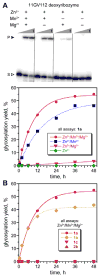DNA-catalyzed glycosylation using aryl glycoside donors
- PMID: 27355482
- PMCID: PMC4945402
- DOI: 10.1039/c6cc04329a
DNA-catalyzed glycosylation using aryl glycoside donors
Abstract
We report the identification by in vitro selection of Zn(2+)/Mn(2+)-dependent deoxyribozymes that glycosylate the 3'-OH of a DNA oligonucleotide. Both β and α anomers of aryl glycosides can be used as the glycosyl donors. Individual deoxyribozymes are each specific for a particular donor anomer.
Figures




Similar articles
-
Carbohydrate-active enzyme-catalyzed stereoselective glycosylation of complex natural product glycosides.Enzyme Microb Technol. 2025 Apr;185:110589. doi: 10.1016/j.enzmictec.2025.110589. Epub 2025 Jan 22. Enzyme Microb Technol. 2025. PMID: 39864143
-
Phosphoserine Lyase Deoxyribozymes: DNA-Catalyzed Formation of Dehydroalanine Residues in Peptides.J Am Chem Soc. 2015 Aug 5;137(30):9575-8. doi: 10.1021/jacs.5b06308. Epub 2015 Jul 27. J Am Chem Soc. 2015. PMID: 26200899 Free PMC article.
-
DNA-Catalyzed Introduction of Azide at Tyrosine for Peptide Modification.Angew Chem Int Ed Engl. 2016 Aug 16;55(34):10052-6. doi: 10.1002/anie.201604364. Epub 2016 Jul 8. Angew Chem Int Ed Engl. 2016. PMID: 27391404 Free PMC article.
-
Deoxyribozymes: DNA catalysts for bioorganic chemistry.Org Biomol Chem. 2004 Oct 7;2(19):2701-6. doi: 10.1039/B411910J. Epub 2004 Sep 3. Org Biomol Chem. 2004. PMID: 15455136 Review.
-
In vitro selection, characterization, and application of deoxyribozymes that cleave RNA.Nucleic Acids Res. 2005 Nov 11;33(19):6151-63. doi: 10.1093/nar/gki930. Print 2005. Nucleic Acids Res. 2005. PMID: 16286368 Free PMC article. Review.
Cited by
-
DNAmoreDB, a database of DNAzymes.Nucleic Acids Res. 2021 Jan 8;49(D1):D76-D81. doi: 10.1093/nar/gkaa867. Nucleic Acids Res. 2021. PMID: 33053178 Free PMC article.
-
DNA-Templated N(Me)-Alkoxyamine Glycosylation.Org Lett. 2018 Mar 16;20(6):1496-1499. doi: 10.1021/acs.orglett.8b00113. Epub 2018 Mar 7. Org Lett. 2018. PMID: 29513541 Free PMC article.
References
-
- Schlosser K, Li Y. Chem Biol. 2009;16:311–322. - PubMed
- Silverman SK. Acc Chem Res. 2009;42:1521–1531. - PMC - PubMed
- Silverman SK. Angew Chem Int Ed. 2010;49:7180–7201. - PMC - PubMed
- Chandra M, Sachdeva A, Silverman SK. Nat Chem Biol. 2009;5:718–720. - PMC - PubMed
- Parker DJ, Xiao Y, Aguilar JM, Silverman SK. J Am Chem Soc. 2013;135:8472–8475. - PMC - PubMed
MeSH terms
Substances
Grants and funding
LinkOut - more resources
Full Text Sources
Other Literature Sources

